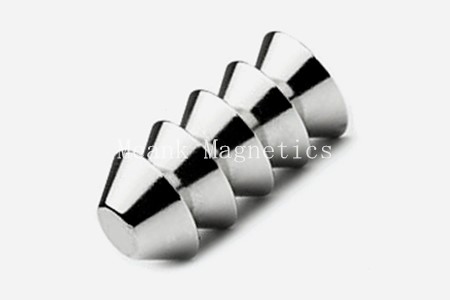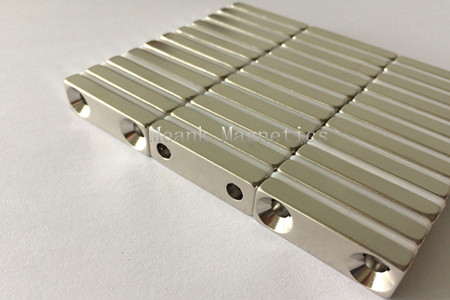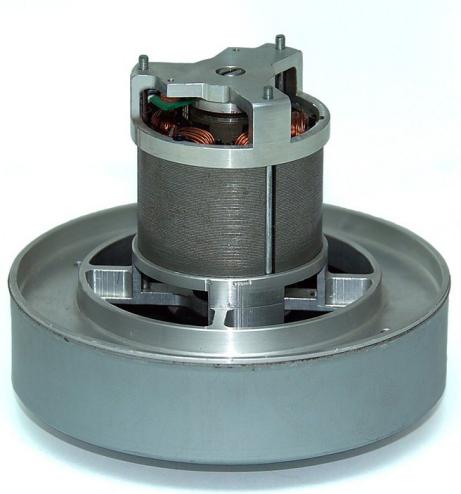Neodymium magnets, known for their remarkable magnetic strength, are the strongest permanent magnets available. These magnets stand out not only for their power but also for their efficient use in a variety of advanced applications. This article delves into the manufacturing process of neodymium magnets, comparing them with ceramic magnets, and examining their unique properties. By understanding these distinctions, customers can better appreciate why neodymium magnets are often the magnet of choice in high-performance and precision-based industries.
A neodymium magnet is a type of permanent magnet known for its exceptional magnetic strength. It is considered the strongest magnet available, offering a significantly higher magnetic energy density compared to other types of permanent magnets. Neodymium magnets are highly efficient in retaining their magnetism over time, maintaining stable magnetic performance even under extreme conditions. They are often characterized by their small size relative to their powerful magnetic fields, making them ideal for applications requiring compact yet highly effective magnetic forces.

The manufacturing of neodymium magnets is a highly sophisticated and multi-step process that requires precision at every stage. One key perspective is the complexity involved in achieving the optimal magnetic properties. The alloy composition must be carefully controlled to balance the right proportion of neodymium, iron, and boron, as even slight variations can impact the magnet’s strength and stability. This underscores the advanced metallurgical expertise required to produce high-quality magnets that meet stringent industrial standards.
Another insightful aspect is the importance of the sintering process. Sintering not only enhances the magnetic strength but also improves the structural integrity of the magnet. By compressing the powder into a solid form and subjecting it to high temperatures, the material undergoes a phase change, increasing its density and magnetic alignment. This process is crucial because it directly influences the magnet's energy density—the ability to maintain a strong magnetic field in a compact form.

Moreover, the post-sintering machining and coating processes highlight the emphasis on durability and performance. Since bulk neodymium magnets are highly susceptible to corrosion, protective coatings are vital to extend their lifespan, especially in challenging environments. This reflects the trade-off manufacturers must manage between magnetic performance and environmental factors such as moisture, temperature, and chemical exposure.
Neodymium magnets and ceramic magnets (ferrite magnets) are two of the most widely used permanent magnets, each with distinct characteristics that make them suitable for different applications.
Neodymium magnets are made from an alloy of neodymium, iron, and boron. Neodymium, a rare-earth element, is the key factor behind their exceptional magnetic properties. Iron and boron further enhance the magnet’s stability and strength. Ceramic magnets (ferrite magnets) is composed primarily of iron oxide combined with either barium or strontium carbonate, ceramic magnets are made from more abundant and cost-effective materials compared to neodymium.
Known for their extraordinary strength, neodymium magnets are the strongest permanent magnets available, offering a high magnetic energy density. Their maximum energy product can exceed 50 MGOe, making them far more powerful than ceramic magnets. By contrast, ceramic magnets are weaker, with an energy product typically in the range of 1-5 MGOe. While they don’t match the strength of neodymium, their magnetic performance is sufficient for many everyday applications.
The higher cost of neodymium magnets is due to the rarity of neodymium and the complex manufacturing processes involved in their production. Their price reflects the scarcity of raw materials and the advanced techniques needed to shape them. While ceramic magnets are significantly more affordable. The raw materials used for their production are plentiful, and the simpler manufacturing process keeps costs low, making them an attractive option for cost-sensitive applications.
Producing neodymium magnets involves a precise and multi-step process. After the alloy is formed, it is powdered, sintered, and then magnetized. The resulting magnet is then machined to exact specifications, which requires specialized equipment and expertise. Whereas, the manufacturing process for ceramic magnets is less complex. The iron oxide is mixed with barium or strontium carbonate, sintered at high temperatures, and magnetized, resulting in a durable but less powerful product.
Although neodymium magnets offer exceptional strength, they are more sensitive to heat. Prolonged exposure to temperatures above 80-200°C can lead to demagnetization. However, advanced coatings and alloy modifications can improve their heat resistance. Compared with neodymium magnets, ceramic magnets are more heat-resistant, with the ability to maintain their magnetic properties even at temperatures up to 250°C. This makes them ideal for applications that require high-temperature stability.
Neodymium magnets are highly susceptible to corrosion and require protective coatings such as nickel or epoxy to prevent oxidation, especially in humid environments. But ceramic magnets naturally exhibit excellent corrosion resistance, making them more durable in outdoor or harsh environments where moisture exposure is common.
Neodymium magnets require a stronger external magnetizing field to align their magnetic domains and achieve high levels of magnetism. This precise control during manufacturing is key to their superior strength. Ceramic magnets, while effective, are magnetized by a less intense field, resulting in a lower overall magnetic strength compared to neodymium magnets.
Neodymium magnets are highly compact while maintaining impressive magnetic strength. This is due to their high energy density, allowing them to exert significant force in a small package. While ceramic magnets generally require larger sizes to produce the same magnetic force as a smaller neodymium magnet. This makes them less suitable for applications where a strong magnetic field is needed in tight spaces.
Due to their small size and powerful magnetic field, neodymium magnets are indispensable in high-performance applications such as motors (electric vehicles, robotics), medical devices (MRI machines, hearing aids), and electronics (hard drives, speakers). Their strength-to-size ratio allows them to be used in compact, efficient designs.

Ceramic magnets, with their cost-effectiveness and durability, are ideal for low-cost applications where extreme magnetic strength is not required. Common uses include low-cost motors, speakers, refrigerator magnets, and automotive components.
| Feature | Neodymium Magnets | Ceramic Magnets |
| Material Composition | Alloy of neodymium, iron, and boron | Iron oxide combined with barium or strontium carbonate |
| Magnetic Strength | Strongest permanent magnets, with energy product > 50 MGOe | Weaker magnets, energy product typically 1-5 MGOe |
| Cost | Higher cost due to rarity of neodymium and complex process | More affordable due to abundant materials and simpler process |
| Manufacturing Process | Multi-step process: alloy formation, powdering, sintering, magnetizing | Simpler process: mixing, sintering, and magnetizing |
| Temperature Resistance | Sensitive to heat, demagnetizes above 80-200°C | More heat-resistant, maintains properties up to 250°C |
| Corrosion Resistance | Highly susceptible to corrosion, requires coatings | Naturally corrosion-resistant |
| Magnetization Process | Requires a strong external magnetizing field | Magnetized by a less intense field, resulting in weaker strength |
| Size and Form Factor | Compact, small size with high strength | Requires larger sizes to achieve similar strength |
| Applications | High-performance applications: motors, medical devices, electronics | Cost-effective, durable for low-cost applications like motors, speakers, and automotive components |
Looking to the future, the demand for neodymium magnets is set to increase as industries continue to seek more compact and powerful magnetic solutions. With their unmatched strength and small form factor, neodymium magnets are essential for emerging technologies in electric vehicles, renewable energy, robotics, and medical devices. While challenges such as cost and heat sensitivity remain, ongoing advancements in material science and manufacturing processes promise to enhance their durability and affordability. As these innovations unfold, neodymium magnets will remain at the forefront of driving efficiency and performance in a wide range of applications.
